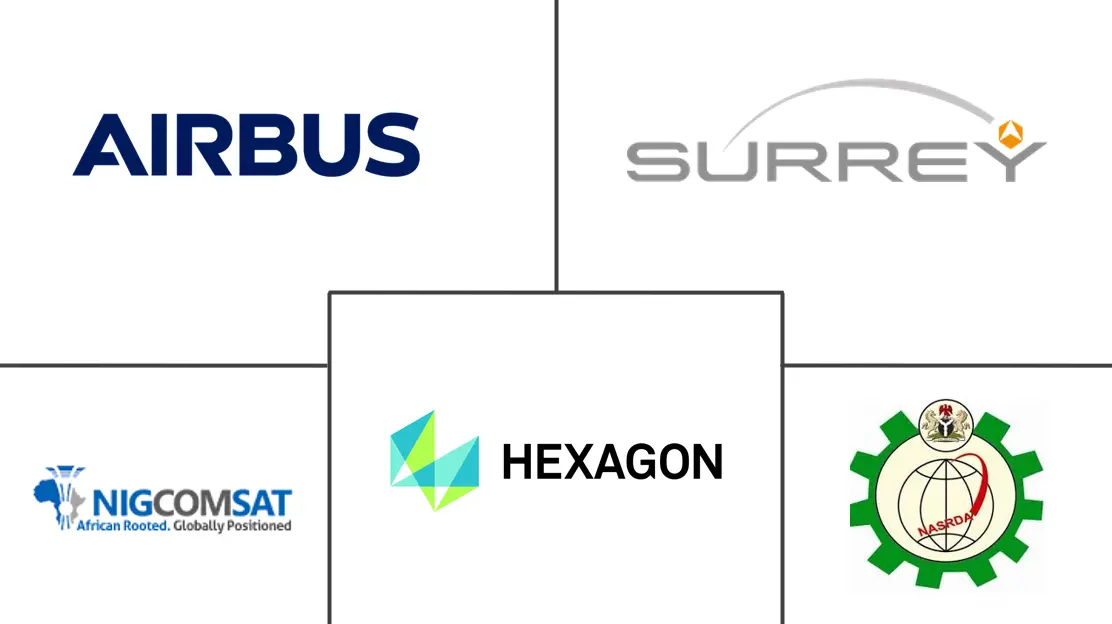Nigeria Satellite-based Earth Observation Market Size and Share
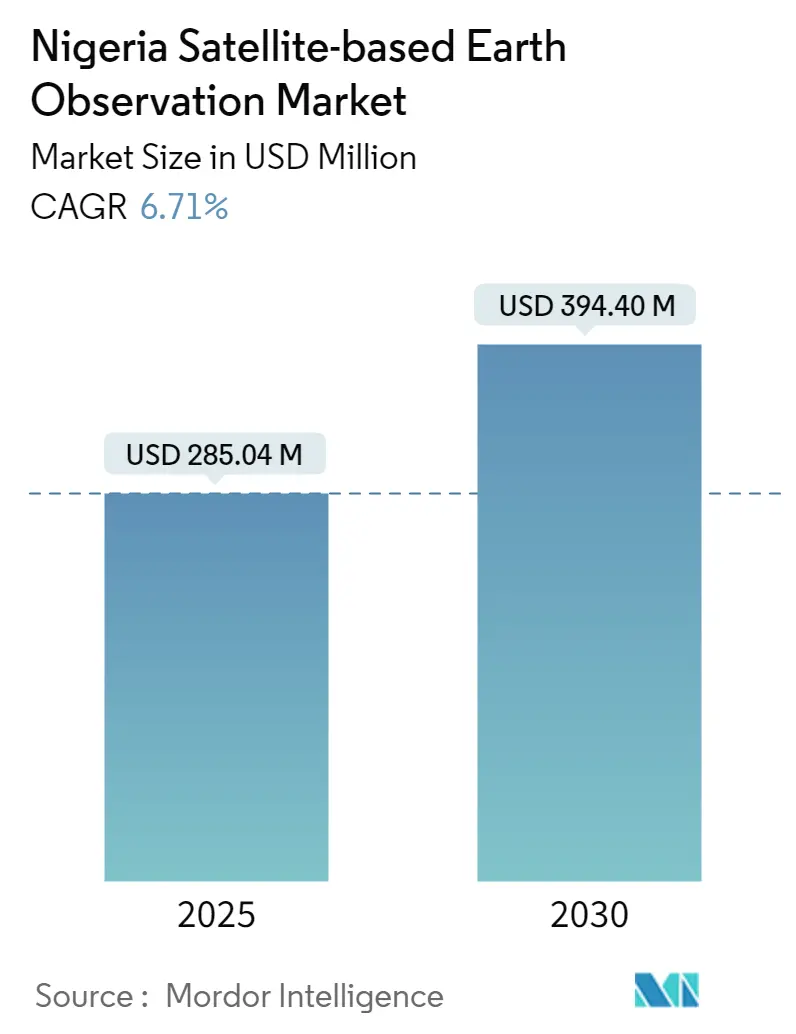
Nigeria Satellite-based Earth Observation Market Analysis by Mordor Intelligence
The Nigeria Satellite-based Earth Observation Market size is estimated at USD 285.04 million in 2025, and is expected to reach USD 394.40 million by 2030, at a CAGR of 6.71% during the forecast period (2025-2030).
Nigeria's continuing economic development and infrastructure development are expected to increase the demand for satellite earth observation services. Governments, private companies, and other stakeholders might need accurate geospatial information for city planning, infrastructure development, and resource management, thereby creating potential opportunities for market growth.
- Nigeria is gradually focusing on space technology and satellite-based ground observation capabilities. The National Space Research and Development Agency (NASRDA) is the government responsible for coordinating national projects. NASRDA has been Nigeria's prominent space agency to build and deploy satellites in the country to serve various industries.
- NigeriaSat-1, the nation's first Earth observation satellite, was launched twenty years ago, marking the beginning of Nigeria's involvement in satellite technology. NASRDA and Surrey Satellite Technology Limited (SSTL), a UK-based company, worked together on it. Nigeria has since launched several other satellites, notably NigeriaSat-2 and NigeriaSat-1. These satellites were created to deliver detailed data and imagery for various uses, including forestry, agriculture, disaster relief, and urban planning.
- Moreover, Nigeria has remote and hard-to-reach regions where traditional data collection methods may need to be revised. Satellite-based Earth observation could offer a cost-effective way to gather information and bridge data gaps in such areas, which could be a potential driver for market growth in the country.
- One of the primary challenges for Nigeria's satellite-based Earth observation market is the availability of adequate funding. Developing and launching satellites and maintaining and operating the necessary infrastructure requires substantial financial investments. Limited funding from the government and other sources may hinder the implementation of ambitious satellite projects and expanding Earth observation capabilities.
Nigeria Satellite-based Earth Observation Market Trends and Insights
Increasing Focus on Connectivity and Data Accessibility to Drive the Market Growth
- As the demand for satellite internet and digital connectivity grows in Nigeria, it leads to improved infrastructure development, including ground stations and communication networks. This increased connectivity facilitates the efficient reception and transmission of data from Earth observation satellites. As a result, the accessibility of Earth observation data becomes more widespread and seamless.
- Moreover, with greater emphasis on improving data accessibility, efforts are directed towards developing user-friendly platforms and interfaces that allow various stakeholders, such as government agencies, researchers, industries, and healthcare providers, to access and utilize Earth observation data effectively.
- The total number of satellite internet subscriptions can serve as a proxy for the level of internet connectivity and technological adoption in Nigeria. More satellite internet subscriptions indicate a growing demand for internet services, which can positively affect the satellite-based Earth observation market. Increased internet connectivity implies better data transmission and accessibility, making receiving and processing Earth observation data easier.
- The combination of increased connectivity and enhanced data accessibility creates an environment conducive to adopting and utilizing satellite-based Earth observation services. It empowers stakeholders to make informed decisions, research, and develop innovative applications across agriculture, disaster management, environmental monitoring, urban planning, and healthcare sectors.
- In summary, the increasing focus on Connectivity and Data Accessibility drives the Nigeria Satellite-based Earth Observation market by enabling better data transmission, expanding the user base, and fostering the effective utilization of Earth observation data for various applications.
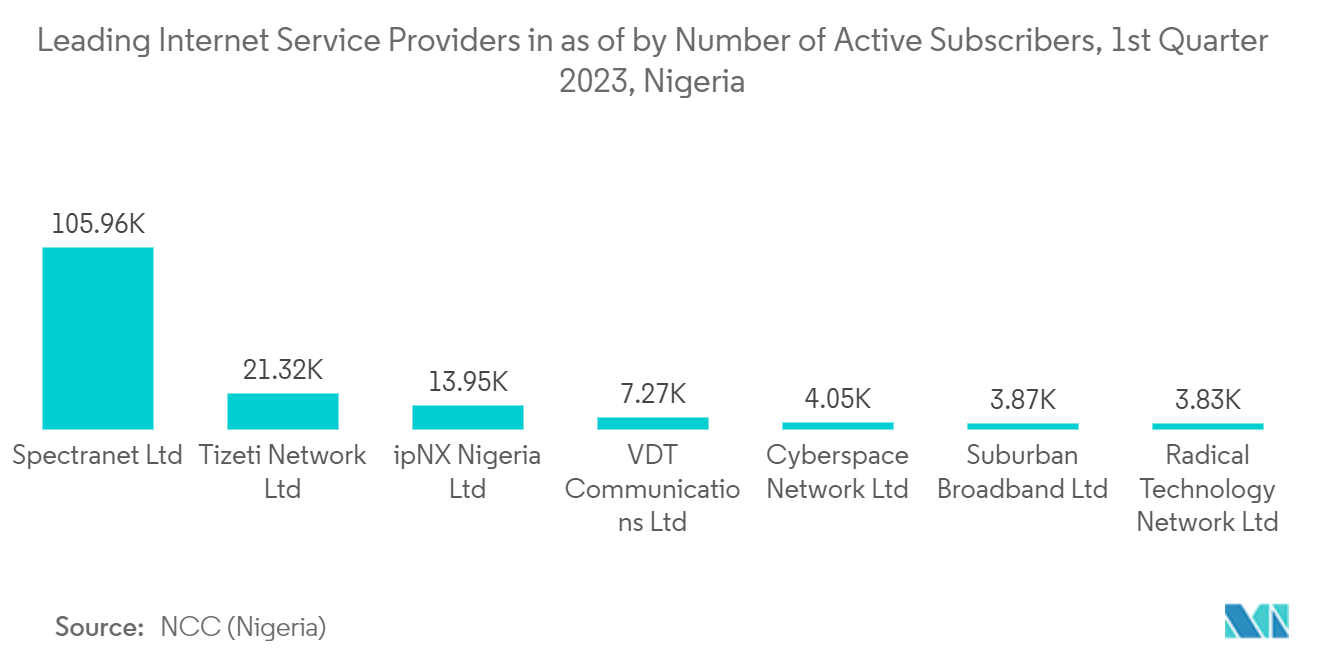
Agriculture End-use Segment to Hold a Significant Market Share
- Satellite-based Earth observation offers valuable tools and data for agriculture. Earth observation satellites can monitor various agricultural parameters, including crop health, soil moisture, land use, and weather patterns. Such data can help identify regions facing food insecurity, assess crop conditions, and support early warning systems for droughts or other natural disasters affecting agricultural productivity.
- Moreover, Earth observation is crucial in disaster management and building food resilience in a country prone to weather-related challenges. By monitoring weather patterns and environmental conditions, satellites can aid in predicting and mitigating the impact of extreme events on agriculture, thereby enhancing food security.
- In addition, as per the IMF records, by 2028, almost 256.86, in million inhabitants, Nigeria total population .Due to rising food prices and a rapidly expanding population, acute food insecurity has become more prevalent in Nigeria than it was a few years ago.
- Consequently, these persistently high levels of extreme food insecurity in Nigeria over the years may indicate the enormous difficulties the agricultural sector still has in ensuring food distribution, production, and security. The high rates of food insecurity demonstrate the need for effective and innovative solutions to issues, including inefficient resource management, poor agricultural yields, and susceptibility to environmental factors.
- The prevalence of food insecurity in Nigeria can trigger increased attention from the government and policymakers to address agricultural challenges. For example, NigeriaSat2 was primarily designed for agricultural applications. As a result, there may be a growing interest in investing in satellite-based Earth observation technologies to support agriculture and improve food security.
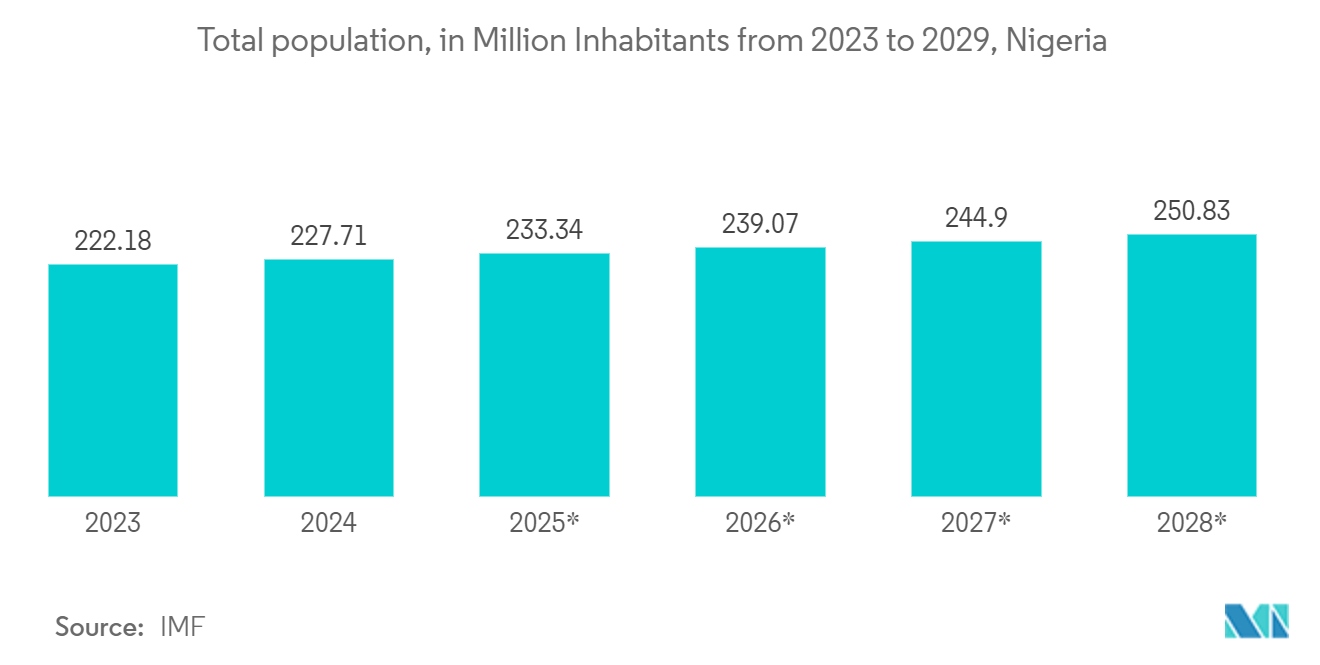
Competitive Landscape
The Nigeria Satellite-based Earth Observation market is expected to be semi-consolidated. The market is still in its early stages of development, and multiple players, including government agencies, private companies, and international organizations, were involved in satellite-based Earth observation activities. NIGCOMSAT Ltd, National Space Research and Development Agency (NASRDA), Surrey Satellite Technology Limited (SSTL), Airbus SE, and Hexagon AB are a few prominent players operating in the market.
In March 2023, the Board and Management staff of the Nigerian Communications Satellite (NIGCOMSAT) Ltd. decided to re-validate the business's objectives to properly align with the requirements of the Fourth Industrial Revolution (4IR) and the realities of volatility, uncertainty, complexity, and ambiguity. This is part of a deliberate effort to reorganize the company's operations for optimal success.
In February 2023, the Nigerian Communications Satellite Ltd. (NIGCOMSAT), the Augmented Navigation for Africa (ANGA) program, and Thales Alenia Space, a joint venture between Thales (67%) and Leonardo (33%), were all working together to accelerate the development of SBAS for aviation in Africa. The objective was to demonstrate on a practical level the effectiveness of the satellite navigation technology created by the ANGA program, which was started by the Agency for Air Navigation Safety in Africa and Madagascar (ASECNA) and aims to provide autonomous SBAS services across the continent to improve the performance of the GPS constellation.
Nigeria Satellite-based Earth Observation Industry Leaders
-
NIGCOMSAT Ltd
-
National Space Research and Development Agency (NASRDA)
-
Surrey Satellite Technology Limited (SSTL)
-
Airbus SE
-
Hexagon AB
- *Disclaimer: Major Players sorted in no particular order
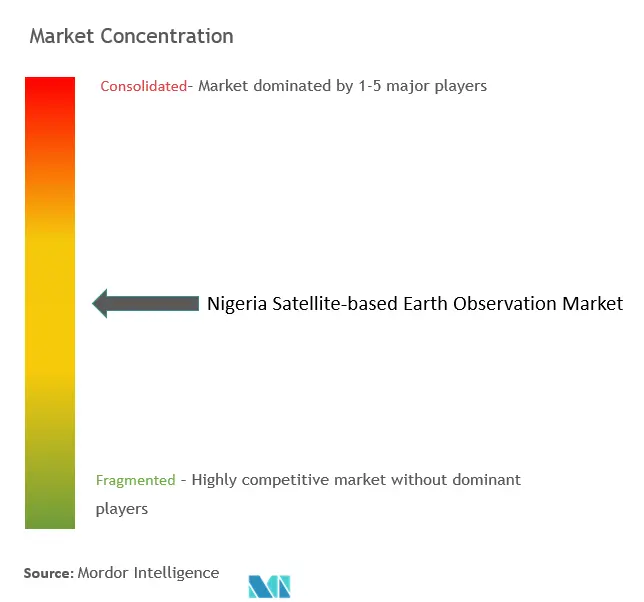
Recent Industry Developments
- May 2023: Nigeria's National Space Research and Development Agency (NASRDA) has become part of the Group on Earth Observations (GEO) GEO-Nigeria, joining South Africa as the second African country to participate. GEO is a worldwide network of 100 country governments and an international organization that enhances Earth Observations (EO) data availability, access, and usage for a sustainable planet and promotes informed decisions and actions using EO data.
- September 2022: A three-day interinstitutional workshop was held by the National Space Research and Development Agency (NASRDA), UN-SPIDER, and the Centre for Remote Sensing of Land Surfaces (ZFL) of the University of Bonn to enhance disaster preparation in the event of considerable floods in Nigeria. The workshop focused on using space-based data provided by emergency mechanisms like the International Charter Space and Major Disasters and services by the Copernicus program, like the Global Flood Awareness System (GLOFAS), to take note of potential floods. The training featured a simulated International Charter Space and Major Disasters activation, which made it easier to use its Charter Mapper to expedite the analysis of satellite imagery.
Nigeria Satellite-based Earth Observation Market Report Scope
Satellite-based earth observation is done with the help of satellites orbiting around the planet to view and identify environmental changes, map making, etc. Satellite-based earth observation technology captures and stores information from satellites relating to the physical, biological, and chemical compositions of the earth for monitoring, surveillance, and decision-making in various verticals, such as defense and intelligence, infrastructure and engineering, natural resource management, energy and power, and disaster management.
Nigeria's satellite-based earth observation market is segmented by type (earth observation data, value-added services), satellite orbit (low earth orbit, medium earth orbit, geostationary orbit), and end-use (urban development and cultural heritage, agriculture, climate services. energy and raw materials, infrastructure). The market sizes and forecasts are provided in terms of value (USD) for all the above segments.
| Earth Observation Data |
| Value Added Services |
| Low Earth Orbit |
| Medium Earth Orbit |
| Geostationary Orbit |
| Urban Development and Cultural Heritage |
| Agriculture |
| Climate Services |
| Energy and Raw Materials |
| Infrastructure |
| Other End-Uses |
| By Type | Earth Observation Data |
| Value Added Services | |
| By Satellite Orbit | Low Earth Orbit |
| Medium Earth Orbit | |
| Geostationary Orbit | |
| By End-use | Urban Development and Cultural Heritage |
| Agriculture | |
| Climate Services | |
| Energy and Raw Materials | |
| Infrastructure | |
| Other End-Uses |
Key Questions Answered in the Report
How big is the Nigeria Satellite-based Earth Observation Market?
The Nigeria Satellite-based Earth Observation Market size is expected to reach USD 285.04 million in 2025 and grow at a CAGR of 6.71% to reach USD 394.40 million by 2030.
What is the current Nigeria Satellite-based Earth Observation Market size?
In 2025, the Nigeria Satellite-based Earth Observation Market size is expected to reach USD 285.04 million.
Who are the key players in Nigeria Satellite-based Earth Observation Market?
NIGCOMSAT Ltd, National Space Research and Development Agency (NASRDA), Surrey Satellite Technology Limited (SSTL), Airbus SE and Hexagon AB are the major companies operating in the Nigeria Satellite-based Earth Observation Market.
What years does this Nigeria Satellite-based Earth Observation Market cover, and what was the market size in 2024?
In 2024, the Nigeria Satellite-based Earth Observation Market size was estimated at USD 265.91 million. The report covers the Nigeria Satellite-based Earth Observation Market historical market size for years: 2019, 2020, 2021, 2022, 2023 and 2024. The report also forecasts the Nigeria Satellite-based Earth Observation Market size for years: 2025, 2026, 2027, 2028, 2029 and 2030.
Page last updated on:
Nigeria Satellite-based Earth Observation Market Report
Statistics for the 2025 Nigeria Satellite-based Earth Observation market share, size and revenue growth rate, created by Mordor Intelligence™ Industry Reports. Nigeria Satellite-based Earth Observation analysis includes a market forecast outlook for 2025 to 2030 and historical overview. Get a sample of this industry analysis as a free report PDF download.
